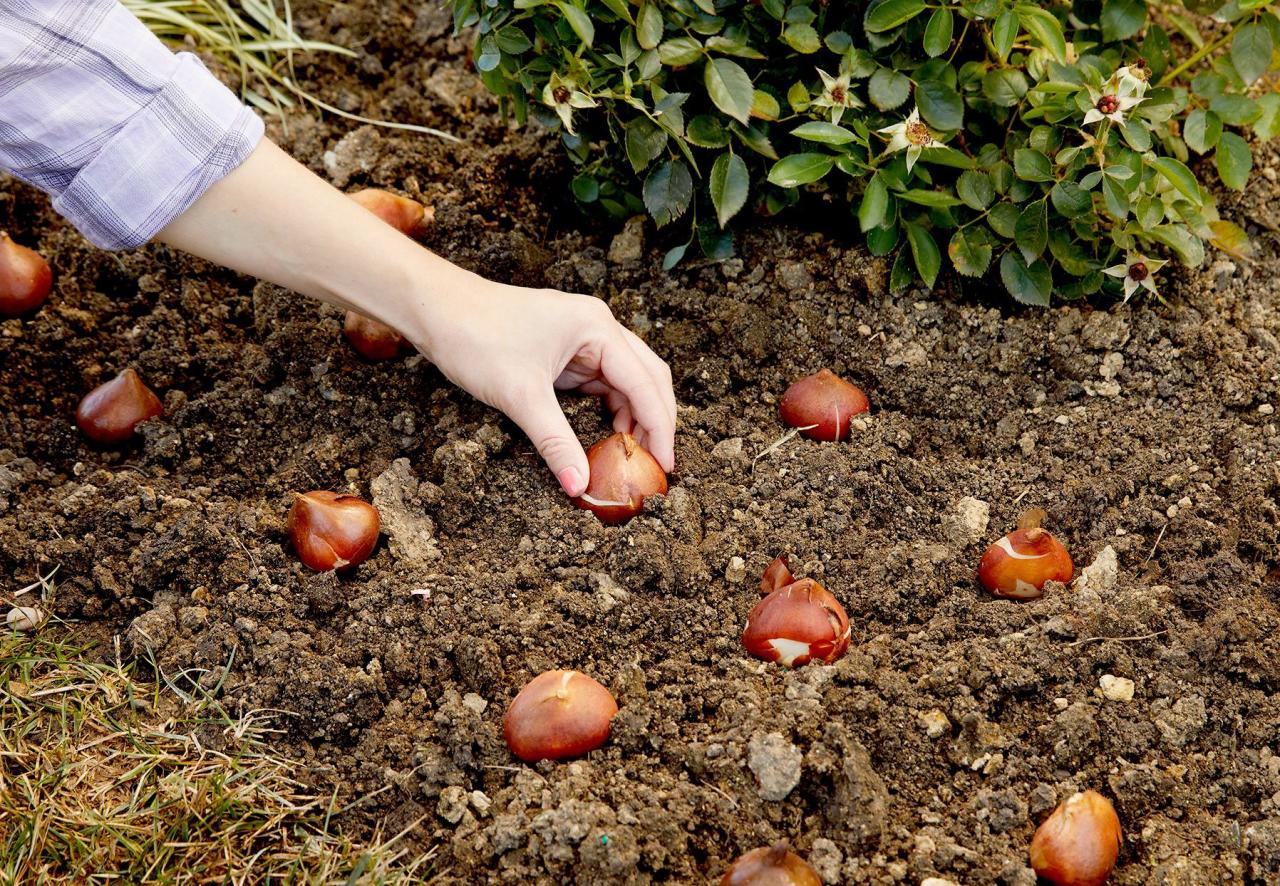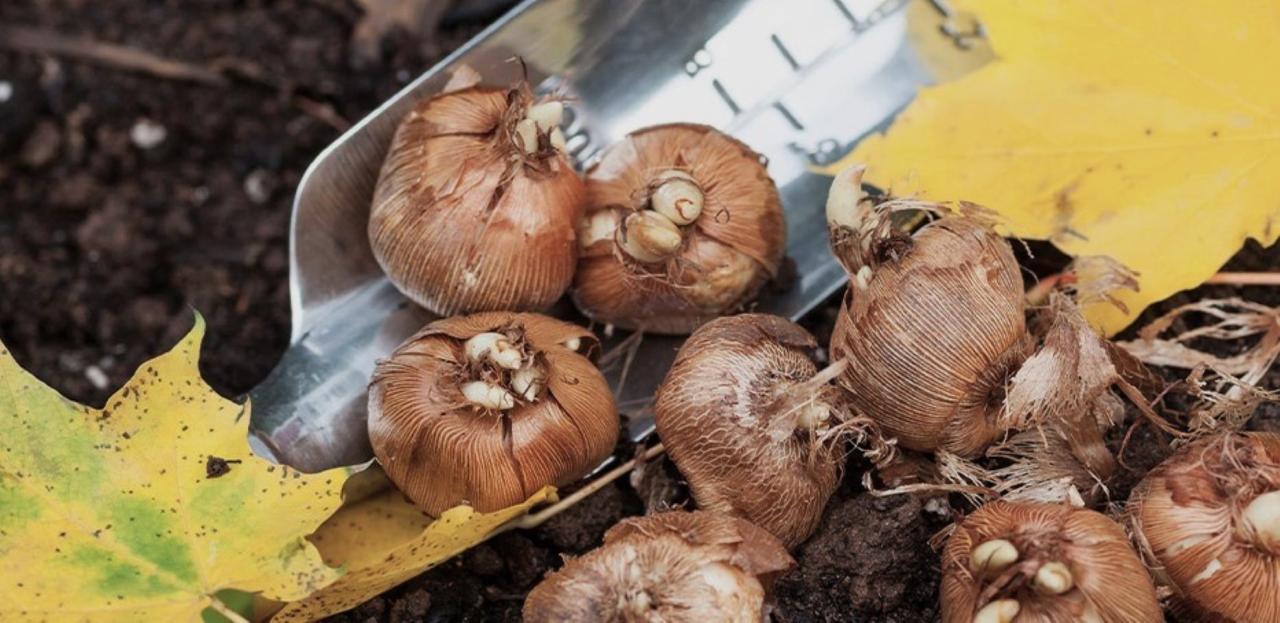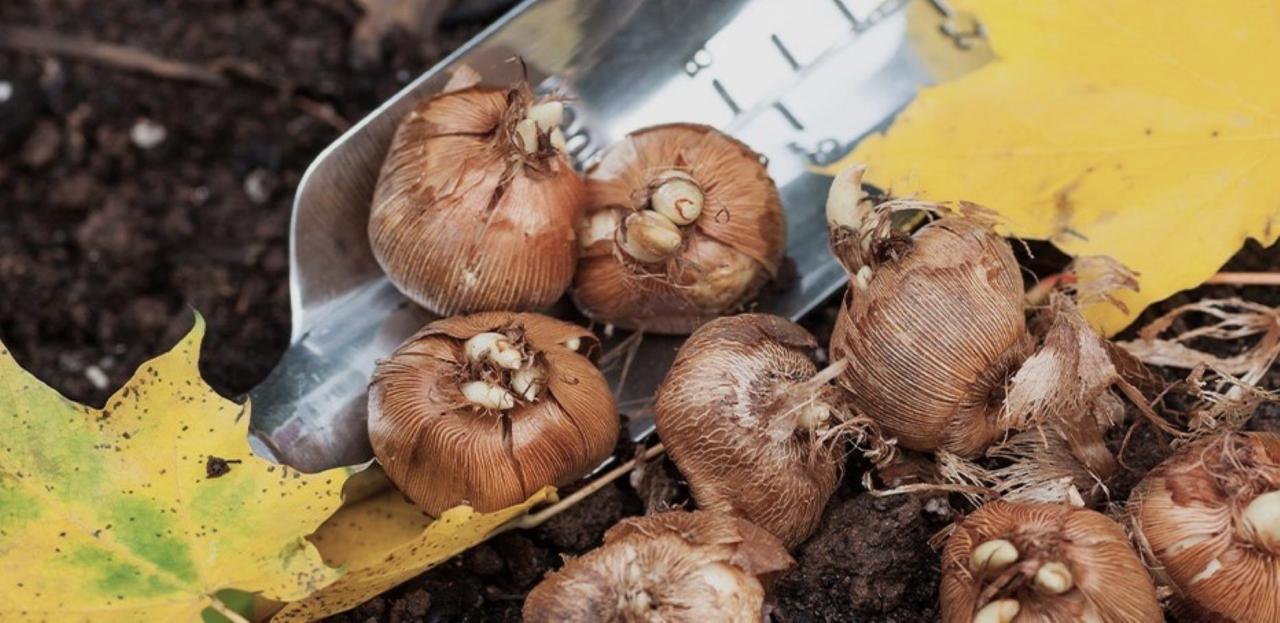How to Mix Flower Colors When Planting Spring Bulbs in Fall is a captivating art that can transform your garden into a vibrant tapestry of blooms. Spring bulbs, with their diverse colors and textures, offer a wonderful opportunity to create stunning visual displays that will bring joy throughout the season.
By understanding the principles of color theory and planning your design carefully, you can achieve a harmonious and eye-catching garden that reflects your personal style.
From the classic combination of blue and yellow to the bold contrast of red and green, the possibilities are endless. This guide will delve into the essential steps for creating a beautiful and flourishing spring bulb garden, from selecting the right bulbs to planting and maintaining them for optimal growth.
Choosing the Right Bulbs

Selecting the right bulbs is crucial for achieving a vibrant and visually appealing spring garden. There are countless varieties of spring-blooming bulbs, each with its unique characteristics, colors, and bloom times. By carefully considering these factors, you can create a captivating display of color and texture that will transform your garden into a blooming paradise.
Color Palettes and Combinations
The beauty of mixing flower colors lies in the endless possibilities for creating unique and harmonious palettes. You can opt for a classic monochromatic scheme, featuring shades of a single color, or embrace a vibrant polychromatic approach, blending multiple colors for a bold and lively effect.
Here are some popular color combinations that can be achieved by mixing spring bulbs:
- Cool Colors:Combine blue, purple, and white bulbs for a calming and serene effect. Examples include:
- Blue: Siberian Squill, Grape Hyacinth
- Purple: Crocus, Hyacinth, Allium
- White: Snowdrop, Galanthus, Anemone
- Warm Colors:Create a cheerful and energetic atmosphere with yellow, orange, and red bulbs. Examples include:
- Yellow: Daffodil, Narcissus, Fritillaria
- Orange: Tulip, Allium
- Red: Tulip, Allium
- Complementary Colors:Enhance the vibrancy of your garden by pairing contrasting colors like yellow and purple, or red and green. Examples include:
- Yellow and Purple: Daffodils and Hyacinths
- Red and Green: Red Tulips and Allium
- Analogous Colors:Achieve a harmonious and balanced look by using colors that are adjacent on the color wheel, such as blue and green, or yellow and orange. Examples include:
- Blue and Green: Siberian Squill and Allium
- Yellow and Orange: Daffodils and Tulips
Popular Spring-Blooming Bulbs
The world of spring bulbs offers a vast array of options, each with its unique characteristics and beauty. To help you navigate this diverse selection, we’ve compiled a list of popular spring-blooming bulbs, along with their colors, heights, bloom times, and growth habits:
Bulb |
Color |
Height |
Bloom Time |
Growth Habit |
|---|---|---|---|---|
Allium (Ornamental Onion) |
Purple, Pink, White, Yellow |
12-36 inches |
Late Spring |
Globe-shaped flower heads on tall stems |
Crocus |
Purple, Yellow, White, Striped |
3-6 inches |
Early Spring |
Small, cup-shaped flowers emerging from the ground |
Daffodil (Narcissus) |
Yellow, White, Orange, Pink |
6-18 inches |
Mid-Spring |
Trumpet-shaped flowers with a central cup |
Fritillaria (Fritillary) |
Purple, Yellow, Orange |
12-24 inches |
Early Spring |
Bell-shaped flowers with checkered patterns |
Hyacinth |
Purple, Pink, White, Red, Yellow, Blue |
12-18 inches |
Mid-Spring |
Strongly scented, bell-shaped flowers on tall spikes |
Iris |
Purple, Blue, Yellow, White |
12-36 inches |
Late Spring |
Sword-shaped leaves and showy, three-petaled flowers |
Muscari (Grape Hyacinth) |
Blue, Purple, White |
6-12 inches |
Early Spring |
Small, grape-like clusters of flowers |
Snowdrop (Galanthus) |
White |
4-8 inches |
Early Spring |
Delicate, bell-shaped flowers with drooping heads |
Tulip |
Red, Yellow, Pink, Purple, White, Orange, Multicolored |
12-30 inches |
Mid-Spring |
Cup-shaped flowers on tall stems |
Color Theory Basics

Creating a visually appealing spring bulb display requires a basic understanding of color theory. Color theory helps us understand how different colors interact and create specific effects. By applying these principles, you can create harmonious and visually stunning combinations in your garden.
Color Harmony
Color harmony refers to the pleasing arrangement of colors that create a sense of balance and unity. When colors work well together, they create a sense of visual appeal and enhance the overall aesthetic of the garden. There are several types of color harmonies commonly used in design, including:
- Complementary Colors: These are colors that sit opposite each other on the color wheel. Complementary colors create high contrast and a vibrant effect. Examples include:
- Red and Green
- Blue and Orange
- Yellow and Purple
- Analogous Colors: These are colors that sit next to each other on the color wheel. Analogous colors create a harmonious and cohesive look. Examples include:
- Red, Orange, and Yellow
- Blue, Green, and Violet
- Yellow, Green, and Blue
- Monochromatic Colors: These are different shades, tints, and tones of the same color. Monochromatic schemes create a sense of sophistication and elegance. Examples include:
- Different shades of blue, from light sky blue to deep navy
- Various shades of yellow, from pale lemon to rich gold
- A range of pink hues, from soft blush to vibrant magenta
Color Contrast, How to Mix Flower Colors When Planting Spring Bulbs in Fall
Color contrast refers to the difference in lightness or darkness between two colors. High contrast creates a bold and attention-grabbing effect, while low contrast creates a subtle and harmonious look.
High contrast is often used to highlight specific elements, such as a vibrant flower against a dark background.
- High Contrast: This creates a dramatic and eye-catching effect. Consider using a combination of dark and light colors, such as purple tulips against a background of white daffodils.
- Low Contrast: This creates a more subtle and peaceful effect. Using similar shades of colors, such as various shades of pink and purple, will create a soft and harmonious look.
Visual Representation of Color Combinations
Here’s a visual representation of different color combinations for spring bulb planting:
Example 1: Complementary Colors* Image:A bed of red tulips with a backdrop of green foliage.
Description
The vibrant red tulips stand out against the lush green background, creating a strong and captivating contrast. Example 2: Analogous Colors* Image:A mixed border with yellow daffodils, orange tulips, and red hyacinths.
Description
The warm tones of yellow, orange, and red create a cheerful and inviting atmosphere. Example 3: Monochromatic Colors* Image:A cluster of different shades of blue hyacinths.
Description
The different shades of blue create a sophisticated and elegant look, while maintaining a sense of unity.
Planning Your Garden Design
Once you’ve chosen your bulbs and understand the basic principles of color theory, you can start planning the layout of your garden bed. This step involves considering the size and shape of your garden bed, as well as the surrounding landscape and your desired overall aesthetic.
Garden Bed Layout
Creating a visually appealing garden bed layout requires careful consideration of the color combinations you’ve selected and how they will interact within the space. Here’s a sample garden bed layout to illustrate how you can arrange bulbs for a vibrant spring display:* Front:Plant a row of low-growing bulbs like crocuses (purple) and dwarf daffodils (yellow) for a cheerful splash of color at the edge of the bed.
Middle
Create a central focal point with a cluster of taller tulips (red) and hyacinths (pink) for a dramatic visual impact.
Back
Plant a row of late-blooming alliums (purple) and fritillaria (yellow) for a striking contrast and to add height and texture.This is just one example, and you can adjust the bulb types and colors to suit your preferences and the overall style of your garden.
Garden Bed Size and Shape
The size and shape of your garden bed can significantly influence the visual impact of your planting scheme. * Small Garden Beds:For smaller spaces, consider using a limited color palette to avoid overwhelming the area. Focus on using complementary or analogous colors to create a harmonious effect.
Large Garden Beds
Larger gardens offer more flexibility for experimenting with color combinations. You can create bolder contrasts and use a wider range of colors to achieve a dynamic and eye-catching display.
Factors Affecting Visual Impact
Beyond color combinations and garden bed size, other factors can influence the overall visual impact of your spring bulb planting. * Sunlight:The amount of sunlight your garden bed receives directly impacts the blooming time and vibrancy of your bulbs. Ensure you choose bulbs suited to the specific sunlight conditions in your garden.
Soil Conditions
Soil quality and drainage play a crucial role in bulb growth and flowering. Before planting, ensure the soil is well-drained and amend it with compost if necessary to improve fertility.
Surrounding Landscape
Consider the surrounding landscape elements, such as trees, shrubs, and structures, when planning your bulb layout. The colors and textures of these elements can influence the overall visual impact of your garden bed.
Planting Techniques
Planting spring bulbs in the fall is a simple process that can be enjoyed by gardeners of all experience levels. This section will Artikel the key steps involved in planting spring bulbs, including optimal depth and spacing recommendations for various bulb types.
Depth and Spacing Considerations
The depth and spacing at which you plant your bulbs are crucial for their successful growth and flowering. Planting too shallowly can lead to bulbs being exposed to frost and damage, while planting too deeply can hinder their emergence. Here are general guidelines for planting depth and spacing:
- Depth:The general rule of thumb is to plant bulbs at a depth of two to three times the height of the bulb. For example, a tulip bulb that is 2 inches tall should be planted 4-6 inches deep.
- Spacing:The spacing between bulbs depends on the size of the bulb and the desired effect. For smaller bulbs like crocuses, a spacing of 3-4 inches is sufficient. Larger bulbs like tulips and daffodils should be spaced 6-8 inches apart.
Planting Spring Bulbs
- Choose a suitable location:Spring bulbs prefer well-drained soil in a sunny or partially shaded location. Avoid areas with poor drainage, as this can lead to bulb rot.
- Prepare the soil:Dig a hole that is deep enough to accommodate the bulb and the recommended planting depth. Loosen the soil at the bottom of the hole to encourage root growth.
- Place the bulb:Position the bulb in the hole with the pointed end facing upwards. This is the growing point from which the flower stalk will emerge.
- Backfill the hole:Gently cover the bulb with soil, ensuring that it is completely covered. Gently firm the soil around the bulb to ensure good contact.
- Water thoroughly:Water the newly planted bulbs to settle the soil and encourage root growth.
Planting Schedule for Different Bulbs
The optimal planting time for spring bulbs varies depending on the specific type of bulb and your geographic location. The following table provides a general guideline for planting spring bulbs in the fall:
Bulb Type |
Planting Time |
|---|---|
Tulips |
September-October |
Daffodils |
September-October |
Hyacinths |
September-October |
Crocuses |
September-October |
Allium |
September-October |
Fritillaria |
September-October |
Maintaining Your Spring Bulb Garden
Planting spring bulbs in fall is just the first step towards a vibrant display of color come springtime. Ensuring your bulbs thrive requires ongoing care throughout the growing season.
Watering and Fertilizing
Adequate moisture is crucial for spring bulbs to establish a strong root system and produce healthy foliage. During the fall planting season, water thoroughly after planting to settle the soil around the bulbs. Throughout the winter, infrequent watering is usually sufficient, as the ground is typically moist enough.
However, during dry spells, especially in warmer climates, supplemental watering may be necessary. As spring arrives and bulbs begin to sprout, increase the frequency of watering, ensuring the soil remains consistently moist but not waterlogged. Avoid overwatering, which can lead to root rot.
Fertilizing spring bulbs is another important aspect of their care. Apply a balanced fertilizer, such as 10-10-10, in early spring, just as the first shoots emerge. This provides the bulbs with the necessary nutrients to support healthy growth and abundant blooms.
A second application of fertilizer can be given after flowering, promoting foliage growth and the development of next year’s bulbs. Avoid fertilizing late in the season, as this can stimulate new growth that may not have time to harden off before winter.
Protecting Bulbs from Pests and Diseases
While spring bulbs are generally resilient, they can be susceptible to certain pests and diseases.
Common Pests and Diseases
- Bulb Flies:These flies lay their eggs near bulbs, and the larvae feed on the bulbs, causing damage and weakening the plant.
- Nematodes:Microscopic worms that live in the soil and feed on bulb roots, leading to stunted growth and poor flowering.
- Bulb Rot:A fungal disease that can affect bulbs in damp conditions, causing them to rot and decay.
Preventing Pests and Diseases
- Choose healthy bulbs:When purchasing bulbs, inspect them for any signs of damage, rot, or pests.
- Rotate planting locations:Avoid planting bulbs in the same spot year after year to reduce the buildup of pests and diseases.
- Practice good sanitation:Remove and discard any diseased or damaged bulbs promptly to prevent the spread of infections.
- Use preventive measures:Consider using a fungicide or insecticide to protect your bulbs from pests and diseases.
Conclusive Thoughts
With a little planning and knowledge of color theory, you can create a breathtaking spring bulb garden that will be the envy of your neighborhood. By following these steps, you’ll be able to enjoy a vibrant display of colors and textures that will brighten your days and add a touch of magic to your outdoor space.
Remember, the key is to experiment and have fun with your garden design, letting your creativity blossom along with your bulbs!
Questions and Answers: How To Mix Flower Colors When Planting Spring Bulbs In Fall
What is the best time to plant spring bulbs?
The best time to plant spring bulbs is in the fall, typically from September to November, depending on your climate. This allows the bulbs to establish their roots before winter and bloom in the spring.
Can I plant spring bulbs in containers?
Yes, you can plant spring bulbs in containers. Choose a pot with drainage holes and use a well-draining potting mix. Make sure to select bulbs that are appropriate for the size of the container.
What should I do if my spring bulbs don’t bloom?
If your spring bulbs don’t bloom, there could be a few reasons. Ensure they are planted at the correct depth, receive adequate sunlight, and are watered consistently. Pests and diseases can also affect blooming.

